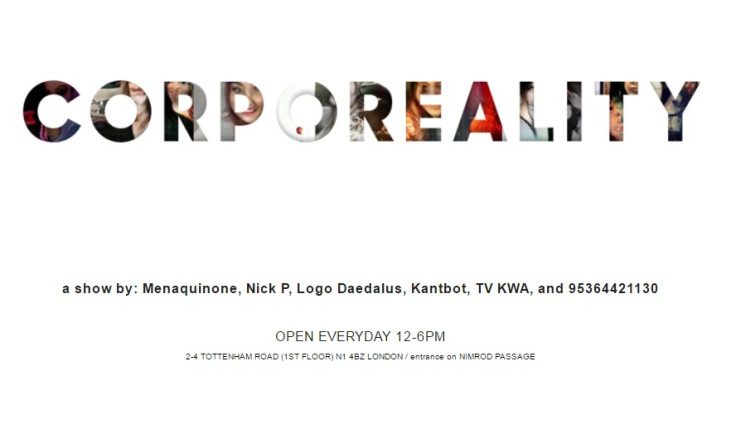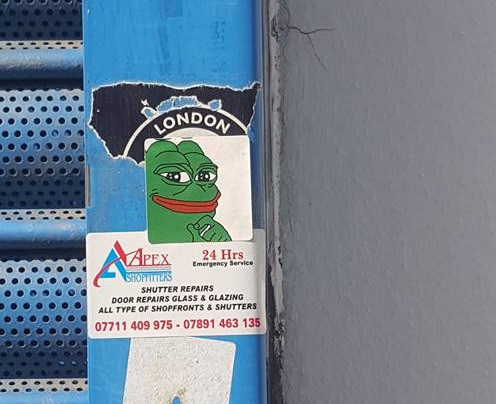Inside frogtwitter's dark artistic mind, where nihilistic satire meets fierce intelligence
Frogtwitter's 'Corporeality' exhibition is on show at the controversial LD50 gallery in Dalston.

The purge was complete. The most fascinating voices of the dark corners of Twitter had been silenced. The frog chorus would croak no more.
But all was not as it seemed. In the darkness, in tiny splintered DM groups, the battle was rejoined. The men of frogtwitter would not be so easily defeated. They would retaliate against censorship by putting on - of all things - an art exhibition.
Enter, at this point, Lucia D, a young artist and proprietor of London's hottest new gallery, LD50. Some of her previous work, at an earlier exhibition hosted in the wake of Donald Trump's remarkable victory, had featured frogtwitter's finest, and, in the wake of the mass bannings, she joined forces with the frogs to create "Corporeality", a coruscating critique of modernity.
The result is an utterly unnerving and enthralling installation, easily the rawest, best thing going in the bland, businesslike, soft-left world of London art.
The gallery in Dalston could easily pass for a long-abandoned shop, were it not for a Pepe sticker discreetly placed on the exterior. In an interview, Lucia told me that the sticker, and others like it, were not her creations, but have been spontaneously appearing all around the area over the last few months, quiet acts of solidarity from London's 4chan community.
On the inside is found an artificial office space, overloaded with print-outs of archived tweets from the purged accounts, transcripts of Trump speeches, and papers from the biological and social sciences that hint at difficult truths. A sign invites you to redact or destroy the material as you see fit. A shredder is available, its refuse lying on the floor, while a video plays of a young man in a suit and an Isis-style balaclava pitching an idea for a start-up with a twist.
As you immerse yourself in the space, the aura of menace builds, compounded by the broken glass and smashed windows, mementoes of an ongoing campaign by local antifascist groups to shut the gallery down.
Regrettably unable to distinguish between a blend of accelerationist neoreaction and satiric performance art on the one hand, and actual Nazism on the other, the antifa have accidentally contributed enormously to the artistic endeavour. By taking on the role of self-appointed censors, they have fulfilled the role in which the installation casts the visitor, and provided a vivid demonstration of the intersections between corporate and public suppression of dissent that the work explores.

It is well to repeat that none of the frogtwitter stars who collaborated with Lucia to create the exhibition are Nazis. Kantbot, who wrote the script for the video, summarised frogtwitter as "the last bastion of indiscriminate and all-embracing cultural criticism"; a space not for ideology, but for pure, truly unfiltered critique. It is an anti-political sphere, in many ways, or perhaps one of a politics of pure aesthetics. He points out that the takeover of conventional activism by corporations, creating a world where supposedly heroic, radical ideologies have become just more brands, has made plentiful artistic space for a truly nihilistic satire.
The magic of frogtwitter lies in the balance between the darkness of their nihilism and the joyous, majestic, life-affirming vitality with which they express it, buttressed by a fierce intelligence. Teeveekwa, the star of the video, told me that they were aware of the likely antifa reaction, and deliberately created the show in such a way that it could subsume the resulting violence ideologically, enhancing the narrative and providing more material for future creations.
As Logo Daedalus, another of the artists, put it: "It's the memetic endpoint of the show, when antifa come in and become wageslaves."

Similarly to Kantbot, Kwa highlighted aesthetics, not conventional politics, as the truest essence of frogtwitter. The fluid, open, anonymously combative atmosphere of Twitter seems to have replicated itself in the gallery, via the spontaneous contributions of antifa and supporters alike. Lucia tells me that she will enter the gallery during the day to find new additions; beautifully drawn frogs, mysterious messages from the anons of the capital.
One anonymous young fellow even flew over from Germany to hold his own silent counter-protest in defence of the gallery, in the face of a howling antifa mob.
Just as technological modernity finds new ways to corrupt the soul - most starkly illustrated in the gallery by Menaquinone's own brilliant creation, a wall of girls from Tinder whose faces have been horribly digitally warped by competing algorithms - so the triumph of the frogs has come to inspire new forms of heroism, so badly needed in a world desperately trying to recreate meaning and dignity out of the ashes of bygone narratives.
As Menaquinone writes: "To the human mind, the product of such competition is infinitely more 'real' than the product of a program of imitation of truth. The battle between generator and discriminator has its genesis in the peculiar contingencies of anisogamy itself, the thermo-game theoretic equilibrium of Apollo and Dionysus, male and female."
Neither, I believe, is the conflict and violence surrounding LD50 incidental, but has, like Mena's duelling algorithms, become essential to the production of its unique artistic witness.
It is unlikely that Lucia D and her co-stars will receive the praise they so richly deserve from the wider art world, but regardless, I confidently predict that LD50 will thrive regardless in one form or another.
It is the herald of a new tech-enhanced consciousness, a thrilling young voice that will not be easily silenced.
Corporeality runs at LD50 in Dalston until 22 May. Opening hours are 12-6.
© Copyright IBTimes 2025. All rights reserved.






















